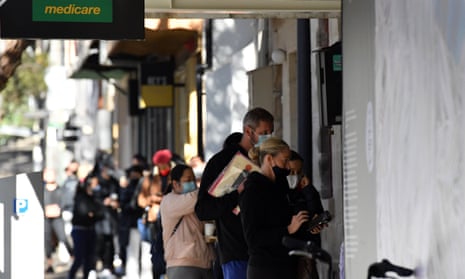Australia’s jobless rate plunged in November as locked down states opened up, with employers defying expectations to add a record number of jobs.
Last month, the unemployment rate came in at 4.6%, a 0.6 percentage point improvement on the October figures, with 366,100 jobs added, the Australian Bureau of Statistics said. Economists had predicted a 5% rate and about 200,000 new jobs for the month.
The new jobs smashed the previous high for any month, beating the 237,600 tally added in June 2020 after the first economic snap-back after the arrival of Covid.
The dive in jobless numbers came even as many more people resumed the search for work, a shift that typically nudges the rate higher. The participation rate surged 1.4 percentage points in the month, to 66.1%, and is now higher than pre-Covid pandemic levels, the ABS said.
Westpac, which had predicted the jobless rate would edge higher to 5.3%, with 200,000 jobs, said the labour market had significantly outperformed expectations.
“Total employment is now higher than it was back in June 2021, [before] the latest round of lockdowns,” Justin Smirk, a senior Westpac economist, said in a briefing note.
He also noted most of the gains were in part-time employment, with 237,800 such positions added.
Bjorn Jarvis, head of labour statistics at the ABS, said: “The latest data shows the extent of recovery between early October and early November in jurisdictions coming out of Delta lockdowns.”
“The easing of restrictions in both NSW and Victoria had a large influence on the national figures, with employment in the two states increasing by 180,000 people and 141,000 people between October and November,” he said.
According to Westpac, underemployment also had a meaningful shift during the month, falling 2 percentage points to 7.5%, the lowest level of underemployment since January 2014.
The Australian dollar rose on the news to 71.8 US cents in recent trade as investors increased their bets on an earlier official interest rate rise than has so far been flagged by the Reserve Bank of Australia.
In a speech on Thursday, RBA governor Philip Lowe said the labour market was expected to tighten further over the next couple of years, and the bank’s “central scenario” is for the jobless rate to reach 4.25% by the end of 2022, and 4% by the end of 2023.
“If we could achieve this, these would be good outcomes – Australia has not experienced a sustained period of unemployment at levels this low since the early 1970s,” he said.
“As the unemployment rate declines and workers become harder to find, greater attention will need to be paid to training and skills development than has been the case over the past few decades,” Lowe said.
The November jobless rate is not far shy of the 4.5% posted in August, which itself was the lowest in more than a decade. The last time the jobless rate was lower was in October 2008, when it was 4.3%, Jarvis of the ABS said.
The latest jobs data comes as the treasurer, Josh Frydenberg, indicated today’s release of the mid-year economic and fiscal outlook would show the unemployment rate dropping below 5%. They also add to signs that the economy – shy of further Covid disruptions – could be running strongly by the time of next year’s elections.
If workers are likely feeling better about their job prospects, households as a whole might also be cheered by signs that their wealth is on the rise as well – at least if they own a home or are paying one off.
In separate figures out today, the ABS said total household wealth increased 4.4%, or $590bn, in the September quarter, to a record $13.92t.
Wealth per capita also rose to a record of $540,179.
“Residential property assets contributed 3.5 percentage points to the quarterly growth in household wealth,” the ABS said, with deposit and superannuation balances adding at 0.6 and 0.4 percentage points, respectively.
An increase in household loans detracted 0.3 percentage points from growth.
“Residential property prices continued to drive household wealth, with prices increasing by 5% during the quarter,” head of finance and wealth at the ABS, Katherine Keenan, said. “Property prices continued to grow strongly, reflecting continued low interest rates and strength in the housing market.”
The $72bn increase in household deposits was the largest on record as people stocked up on cash that was difficult to spend during lockdown and government assistance grew, the ABS said.
